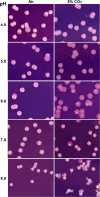pH Regulates White-Opaque Switching and Sexual Mating in Candida albicans
- PMID: 26342021
- PMCID: PMC4621312
- DOI: 10.1128/EC.00123-15
pH Regulates White-Opaque Switching and Sexual Mating in Candida albicans
Abstract
As a successful commensal and pathogen of humans, Candida albicans encounters a wide range of environmental conditions. Among them, ambient pH, which changes frequently and affects many biological processes in this species, is an important factor, and the ability to adapt to pH changes is tightly linked with pathogenesis and morphogenesis. In this study, we report that pH has a profound effect on white-opaque switching and sexual mating in C. albicans. Acidic pH promotes white-to-opaque switching under certain culture conditions but represses sexual mating. The Rim101-mediated pH-sensing pathway is involved in the control of pH-regulated white-opaque switching and the mating response. Phr2 and Rim101 could play a major role in acidic pH-induced opaque cell formation. Despite the fact that the cyclic AMP (cAMP) signaling pathway does not play a major role in pH-regulated white-opaque switching and mating, white and opaque cells of the cyr1/cyr1 mutant, which is defective in the production of cAMP, showed distinct growth defects under acidic and alkaline conditions. We further discovered that acidic pH conditions repressed sexual mating due to the failure of activation of the Ste2-mediated α-pheromone response pathway in opaque A: cells. The effects of pH changes on phenotypic switching and sexual mating could involve a balance of host adaptation and sexual reproduction in C. albicans.
Copyright © 2015, American Society for Microbiology. All Rights Reserved.
Figures




References
Publication types
MeSH terms
Substances
LinkOut - more resources
Full Text Sources
Molecular Biology Databases
Research Materials

